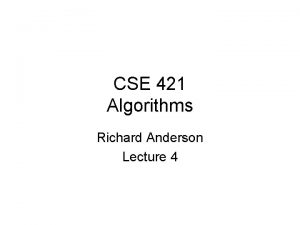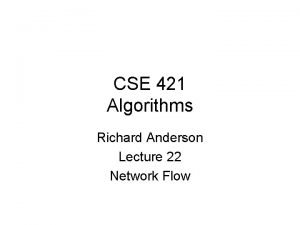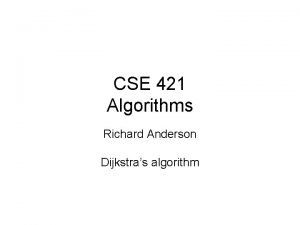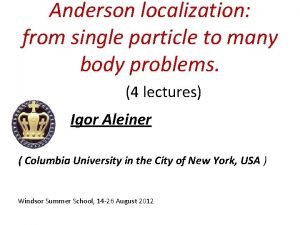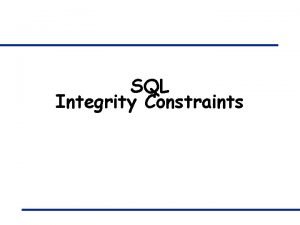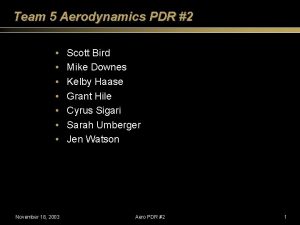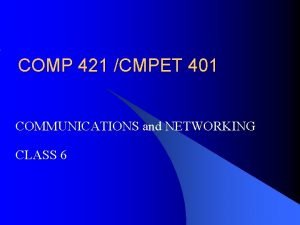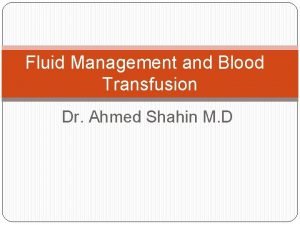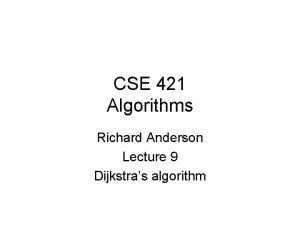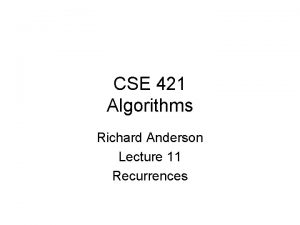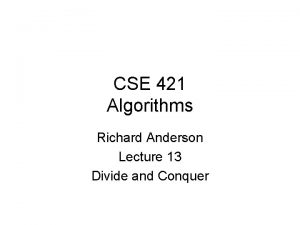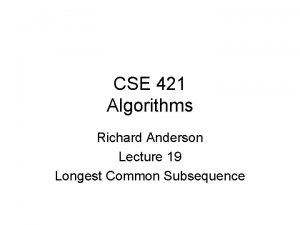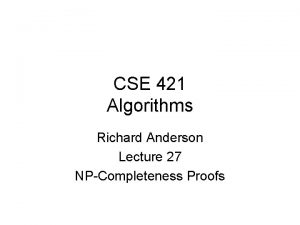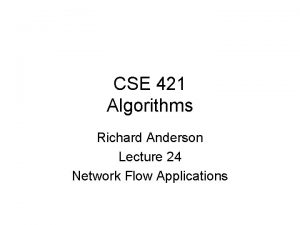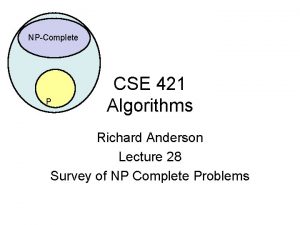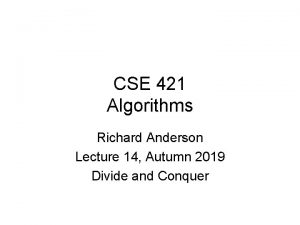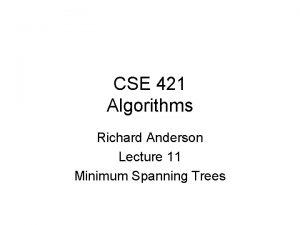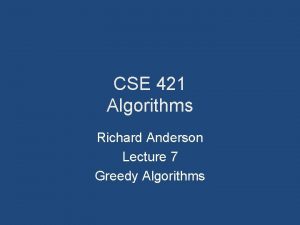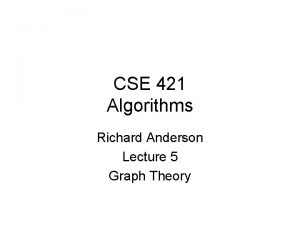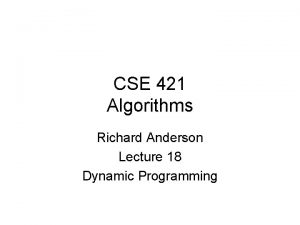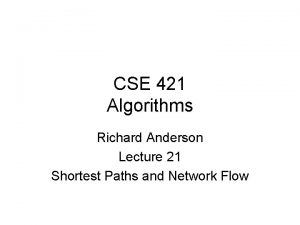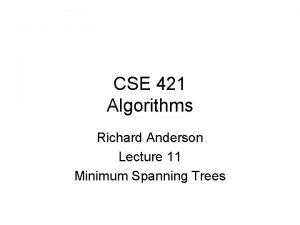CSE 421 Algorithms Richard Anderson Lecture 9 Dijkstras







![Assume all edges have non-negative cost Dijkstra’s Algorithm S = {}; d[s] = 0; Assume all edges have non-negative cost Dijkstra’s Algorithm S = {}; d[s] = 0;](https://slidetodoc.com/presentation_image_h2/692f2cfdc2df2eb0c99a2d496d30ac05/image-8.jpg)





![Proof • Let v be a vertex in V-S with minimum d[v] • Let Proof • Let v be a vertex in V-S with minimum d[v] • Let](https://slidetodoc.com/presentation_image_h2/692f2cfdc2df2eb0c99a2d496d30ac05/image-14.jpg)




- Slides: 18

CSE 421 Algorithms Richard Anderson Lecture 9 Dijkstra’s algorithm

Last Week • Farthest in the future algorithm for optimal caching – Discard element whose first occurrence is last in the sequence A, B, C, A, C, D, C, B, C, A, D

Announcement • Collaboration Policy – Discussing problems with other students is okay – Write ups must be done independently – Acknowledge people you work with

This week • Today – Dijkstra’s Algorithm (Section 4. 4) • Rest of the week – Wednesday: Punya Biswal, SP/MST – Friday: Ben Birnbaum, MST • Reading – 4. 4, 4. 5, 4. 7, 4. 8

Single Source Shortest Path Problem • Given a graph and a start vertex s – Determine distance of every vertex from s – Identify shortest paths to each vertex • Express concisely as a “shortest paths tree” • Each vertex has a pointer to a predecessor on shortest path 1 1 u 2 5 s 3 3 x 4 v u s x 3 v

Construct Shortest Path Tree from s d 2 a 4 s 1 5 4 -3 d 4 e c 3 2 7 e -2 3 g 6 b a f c s g b 3 f

Warmup • If P is a shortest path from s to v, and if t is on the path P, the segment from s to t is a shortest path between s and t t • WHY? s v
![Assume all edges have nonnegative cost Dijkstras Algorithm S ds 0 Assume all edges have non-negative cost Dijkstra’s Algorithm S = {}; d[s] = 0;](https://slidetodoc.com/presentation_image_h2/692f2cfdc2df2eb0c99a2d496d30ac05/image-8.jpg)
Assume all edges have non-negative cost Dijkstra’s Algorithm S = {}; d[s] = 0; d[v] = infinity for v != s While S != V Choose v in V-S with minimum d[v] Add v to S For each w in the neighborhood of v d[w] = min(d[w], d[v] + c(v, w)) 0 s 1 u 1 2 4 2 v 4 y 3 1 1 x 2 2 3 2 z 5

Simulate Dijkstra’s algorithm (strarting from s) on the graph Round Vertex Added a 1 s 3 1 1 c 2 1 4 3 4 6 b 1 3 2 d 4 5 s a b c d

Who was Dijkstra? • What were his major contributions?

http: //www. cs. utexas. edu/users/EWD/ • Edsger Wybe Dijkstra was one of the most influential members of computing science's founding generation. Among the domains in which his scientific contributions are fundamental are – – – – algorithm design programming languages program design operating systems distributed processing formal specification and verification design of mathematical arguments

Dijkstra’s Algorithm as a greedy algorithm • Elements committed to the solution by order of minimum distance

Correctness Proof • Elements in S have the correct label • Key to proof: when v is added to S, it has the correct distance label. y x s u v
![Proof Let v be a vertex in VS with minimum dv Let Proof • Let v be a vertex in V-S with minimum d[v] • Let](https://slidetodoc.com/presentation_image_h2/692f2cfdc2df2eb0c99a2d496d30ac05/image-14.jpg)
Proof • Let v be a vertex in V-S with minimum d[v] • Let Pv be a path of length d[v], with an edge (u, v) • Let P be some other path to v. Suppose P first leaves S on the edge (x, y) – – P = Psx + c(x, y) + Pyv Len(Psx) + c(x, y) >= d[y] Len(Pyv) >= 0 Len(P) >= d[y] + 0 >= d[v] y x s u v

Negative Cost Edges • Draw a small example a negative cost edge and show that Dijkstra’s algorithm fails on this example

Bottleneck Shortest Path • Define the bottleneck distance for a path to be the maximum cost edge along the path u 6 s 2 3 5 x 5 4 v

Compute the bottleneck shortest paths d 6 a 4 s 6 5 4 -3 d 4 e c 3 2 7 e -2 3 g 6 b a f c s g b 4 f

How do you adapt Dijkstra’s algorithm to handle bottleneck distances • Does the correctness proof still apply?
 Uw cse 421
Uw cse 421 Cse 421
Cse 421 Reverse delete algorithm
Reverse delete algorithm Anderson localization lecture notes
Anderson localization lecture notes Analysis of algorithms lecture notes
Analysis of algorithms lecture notes Introduction to algorithms lecture notes
Introduction to algorithms lecture notes Richard dean anderson hockey
Richard dean anderson hockey Richard anderson york university
Richard anderson york university 01:640:244 lecture notes - lecture 15: plat, idah, farad
01:640:244 lecture notes - lecture 15: plat, idah, farad Richard iii and looking for richard
Richard iii and looking for richard [email protected]
[email protected] Ist 421
Ist 421 Integrity constraints in sql
Integrity constraints in sql Fwm 421
Fwm 421 Aae 421
Aae 421 Cs 421
Cs 421 Psy
Psy Comp421
Comp421 Estimated blood volume
Estimated blood volume
